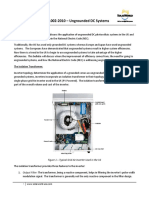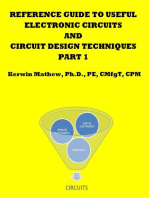Chapter 6 - Wiring Techniques: Phase A
Chapter 6 - Wiring Techniques: Phase A
Uploaded by
Ritesh SharmaOriginal Description:
Original Title
Copyright
Available Formats
Share this document
Did you find this document useful?
Is this content inappropriate?
Report this DocumentCopyright:
Available Formats
Chapter 6 - Wiring Techniques: Phase A
Chapter 6 - Wiring Techniques: Phase A
Uploaded by
Ritesh SharmaCopyright:
Available Formats
Chapter 6 - Wiring Techniques
system. The neutral conductor is typically grounded at the source. If the neutral is
grounded, the portion of the disconnect switch controlling the neutral is not required.
However, if the neutral ground is lost, it would be possible to receive a shock if the neutral
wire were touched. For safety, it is always better to totally disconnect power. Two fuses
are shown, one for hot and one for neutral. Again, if the neutral is grounded the neutral
fuse is not required. However, for the same reason as the disconnect, the second fuse is
desirable since it will protect the system against heavy neutral current that could result if
the ground is lost. Some discussion of the terms hot and neutral may be required here.
Utility power is generally generated as three phase (3N) voltage. This is
accomplished by the wiring scheme in the generator which produces three voltage sources
at a phase angle of 120 from each other. The schematic representation of this type of
generator is shown in Figure 6-2. Notice that the generator has three windings - the
outputs of which are labeled PHASE A, PHASE B and PHASE C. There is also a fourth
terminal on the generator labeled NEUTRAL which is connected to the common connection
of all three phase terminals. For this discussion, assume we are using 120 VAC 3N. If the
generator of Figure 6-2 were producing this voltage, the following voltages would be
present. The voltage from any PHASE (A, B or C) to NEUTRAL would be 120 VAC. The
voltage between any two phases (PHASE A/PHASE B, PHASE B/PHASE C or PHASE
C/PHASE A) would be 208 VAC. The three PHASE leads are referred to as the HOT leads
and the common connection to all three phase windings is referred to as the NEUTRAL
lead. In practice, the NEUTRAL connection is connected to earth ground at the generator.
This is true in residential and commercial buildings with 120 VAC power. The NEUTRAL
wire in the building is connected to earth ground at the panel where power enters the
building. For this reason, if a voltmeter were placed between the NEUTRAL wire and the
safety ground wire in any receptacle, the voltage read would be close to or at 0 VAC.
Phase A
Neutral
Phase C
Phase B
Figure 6-2 - 3-Phase Generator
Schematic
6-3
Chapter 6 - Wiring Techniques
In some cases, PLCs are operated from DC power instead of AC power. Figure 6-3
illustrates the power connection for a PLC requiring DC power, in this case, 24 VDC.
Figure 6-3 - Typical DC Power Wiring
This wiring also includes fusing and disconnecting for both power conductors. If the (-)
power line is grounded at the source, the (-) disconnect and fuse would not be required.
However, as with the AC power wiring, it is always safer to provide for fusing and
disconnection of both power conductors.
Care must be taken to insure that the wiring is properly connected to avoid damage
to the equipment and to the personnel coming into contact with it. For this reason, in this
chapter, a very simplistic approach will be taken to describe wiring techniques. This may
seem insulting to some readers but the hope is that it will explain the wiring requirements
thoroughly enough to allow all readers to understand the principles associated with properly
connecting the PLC to the system.
To connect power to the PLC, the PLC may be thought of as a lightbulb that needs
to be lit; the two power wires are connected to the two wires of the lightbulb and must be
insulated from each other. In the case of a PLC operating on DC power, it may be thought
of as an LED. For a lightbulb, it doesn't matter which power wire connects to which
lightbulb wire; the light will still light up. This is also true for an AC powered PLC. It
6-4
Chapter 6 - Wiring Techniques
generally doesn't matter which power wire is connected to the power terminals as long as
both are connected and insulated from each other. In the case of the LED, though, the (+)
and (-) connections must be made to the proper LED wires and insulated from each other
if the LED is to light. The same is true for the DC powered PLC. The difference with the
PLC is that if it is connected wrong, the damage can be very expensive.
6-4.
Input Wiring
The inputs of modern PLCs are generally opto-isolators. An opto-isolator is a device
consisting of a light producing element such as an LED and a light sensing element such
as a phototransistor. When a voltage is applied to the LED, light is produced which strikes
the photo-detector. The photo-detector then provides an output; in the case of a
phototransistor, it saturates. The separation of the sensing and output devices in the optoisolator provide the input to the PLC with a high voltage isolation since the only connection
between the input terminal and the input to the PLC is a light beam. The light producing
element and any current limiting device and protection components determine the input
voltage for the opto-isolator. For instance, an LED with a series current limiting resistor
could be sized to accept 5 VDC, 24 VDC or 120 VDC. To accept an AC signal, two backto-back LED's with a series current limiting resistor are used. The resistor could be sized
to allow the LED to light with 5 VAC, 24 VAC, 120 VAC or 240 VAC or any voltage we
desire. PLC manufacturers offer different models having various input voltage
specifications. The PLC with the input voltage specification is chosen at the time of
purchase.
Figure 6-4 shows two types of opto-isolators which are utilized. The DC unit is
shown in (a) and the AC unit in (b). The wires from the switch or sensor are connected to
the left side of the drawing. The right side of the device is connected internally to the actual
PLC input. Notice that each opto-isolator has a series resistor to limit the device current.
Also notice that the AC unit has back-to-back LED's inside the device so light is produced
on both half cycles of the input voltage.
6-5
Chapter 6 - Wiring Techniques
Figure 6-4 - Typical PLC Input Circuit
Since the input to the PLC is an LED, we can visualize the wiring of the input by
thinking of it as some type of device controlling a lightbulb and requiring that the input
device lights the lightbulb. The input device may be a switch or some type of on/off sensor
such as a photosensor or proximity sensor, but the problem is always the same; wire the
device so the LED will light when we want the input to be detected as ON. For the DC unit,
you can see that the polarity must be observed for the LED to light. In the case of the AC
unit, since there is a forward biased LED no matter which way current flows, polarity does
not matter. In fact, some manufacturers produce PLC's with AC/DC inputs which are really
the AC unit. When using this type of PLC, the polarity of the input, if it is DC, does not
matter because one of the LED's will light no matter which polarity voltage is applied.
PLC inputs are configured in one of two ways. In some units all inputs are isolated
from each other, that is, there is no common connection between any two inputs. Other
units have one side of each input connected to one common terminal. The PLC utilized
depends on whether the power for all input devices is common or not. The power supply
for the inputs may be either external or internal to the PLC. In low voltage units (24 VDC),
a power supply capable of supplying enough current to turn on all inputs will be internal to
the PLC. If all inputs will be from switches, no other power supply will be required for the
inputs. This internal power supply may not be large enough to also supply any active
sensors (photodetectors or proximity detectors) which may be connected. If not, an
external supply will have to be obtained. The PLC specification will indicate the capacity
of this internal power supply. The internal schematic for the inputs of a PLC having 3 inputs
with common connection is shown in Figure 6-5. One can see that all three opto-isolators
have one wire connected to the same terminal, the INPUT COM. Also, the wire that is
connected to the INPUT COM terminal for each opto-isolator is the negative connection for
6-6
You might also like
- Ghost - BMS - Installation GuideDocument29 pagesGhost - BMS - Installation GuideHector CaceresNo ratings yet
- Introduction to Power System ProtectionFrom EverandIntroduction to Power System ProtectionRating: 4 out of 5 stars4/5 (2)
- Temperature Monitoring System FinalDocument49 pagesTemperature Monitoring System Finals_srireddy78% (9)
- ARCODE Error Codes and Possible Solutions - V2.0 - enDocument36 pagesARCODE Error Codes and Possible Solutions - V2.0 - enmohammed ahmed93% (14)
- Project Report Speed Control of Induction MotorDocument47 pagesProject Report Speed Control of Induction Motorsrajaprojects0% (1)
- Offline Storage: - Diya KaliyambathDocument9 pagesOffline Storage: - Diya KaliyambathDiya KaliyambathNo ratings yet
- Electronics Assignment: by S.rudhraprakash 09lm55 Dme (SW)Document4 pagesElectronics Assignment: by S.rudhraprakash 09lm55 Dme (SW)rvikneshNo ratings yet
- Automated Unified System For LPG UsingDocument84 pagesAutomated Unified System For LPG UsingVirat KaliNo ratings yet
- Recorganising The HardwareDocument13 pagesRecorganising The Hardwareupendra35No ratings yet
- Servicing PLC 120V I/O Modules: 0 CommentsDocument49 pagesServicing PLC 120V I/O Modules: 0 CommentsrajuanthatiNo ratings yet
- Fig 1 - GE Optima CT660 CT ScannerDocument4 pagesFig 1 - GE Optima CT660 CT Scannerarwa zeglamNo ratings yet
- Spice Model Laser Diode 15diDocument8 pagesSpice Model Laser Diode 15diParker333100% (1)
- Short Circuit Protection in DC Low Voltage System: Matrix Institute of Technology, Eee, Cheekatimamidi 1Document64 pagesShort Circuit Protection in DC Low Voltage System: Matrix Institute of Technology, Eee, Cheekatimamidi 1Santosh KumarNo ratings yet
- DC Electronic Load Circuit SchematicDocument4 pagesDC Electronic Load Circuit Schematicnvkjayanth0% (1)
- Application For Industrial Power SupplyDocument5 pagesApplication For Industrial Power SupplySunghoonie KangNo ratings yet
- A Grid Tie Inverter For Solar SystemsDocument5 pagesA Grid Tie Inverter For Solar SystemsR-MarufNo ratings yet
- Transformer Protection SystemDocument57 pagesTransformer Protection SystemAnkit RajNo ratings yet
- TheftDocument12 pagesTheftEmeka Nelson OffornedoNo ratings yet
- Transmission Line Fault MonitoringDocument16 pagesTransmission Line Fault MonitoringVikash Vicky KumarNo ratings yet
- Teardown: The Power Inverter - From Sunlight To Power Grid: Steve TaranovichDocument14 pagesTeardown: The Power Inverter - From Sunlight To Power Grid: Steve TaranovichMinh PHAN THANHNo ratings yet
- Ei Nvq2 Ch06Document32 pagesEi Nvq2 Ch06Nihar RoyNo ratings yet
- Digital Object Counter Using MicrocontrollerDocument60 pagesDigital Object Counter Using MicrocontrollerKishan Amara82% (22)
- Grid Tie Inverter Schematic and Principals of OperationDocument6 pagesGrid Tie Inverter Schematic and Principals of Operation31482No ratings yet
- AC Inputs: Got A Shock? Be Careful) Typically, Ac Input Modules Are AvailableDocument3 pagesAC Inputs: Got A Shock? Be Careful) Typically, Ac Input Modules Are Availableupendra35No ratings yet
- Fault Detection ProjectDocument22 pagesFault Detection Projectmayank choukseyNo ratings yet
- PLC Basics and Voltage Sag Susceptibilities-NEWDocument20 pagesPLC Basics and Voltage Sag Susceptibilities-NEWMouna NjNo ratings yet
- Capacitance Adapter For Multimeter: (Document Subtitle)Document11 pagesCapacitance Adapter For Multimeter: (Document Subtitle)Kashif Hassan100% (1)
- Rbs Engineering Technical Campus Bichpuri, AgraDocument20 pagesRbs Engineering Technical Campus Bichpuri, AgraVipin KushwaNo ratings yet
- Regulated Power SupplyDocument6 pagesRegulated Power Supplypandadillipkumar26No ratings yet
- Variable Ac and DC Power Supplay Using Triac 2014Document3 pagesVariable Ac and DC Power Supplay Using Triac 2014athirasnairNo ratings yet
- RF Controlled ApplianceDocument14 pagesRF Controlled ApplianceNEX456No ratings yet
- Block Diagram: Solar PanelDocument14 pagesBlock Diagram: Solar PanelAakash SheelvantNo ratings yet
- PLC HardwareDocument17 pagesPLC HardwareAnonymous bppsPj8AGNo ratings yet
- Voltage DividerDocument11 pagesVoltage DividerLorshiel Anne TusingNo ratings yet
- 004 Pwm-OcxiDocument7 pages004 Pwm-OcxiNeodymeNo ratings yet
- Report On Power SupplyDocument14 pagesReport On Power SupplyBhavesh MaheshwariNo ratings yet
- SC DIY TCI TriggerDocument15 pagesSC DIY TCI Triggerpedro_pvo3839No ratings yet
- Underground Cable Fault Distance LocatorDocument9 pagesUnderground Cable Fault Distance LocatorThevindra NathNo ratings yet
- OK4U 100W Grid Tie Inverter ManualDocument4 pagesOK4U 100W Grid Tie Inverter Manualdavidmc6375No ratings yet
- Chapter 6: Examples: 6.1 Basic Connecting of The Microcontroller 6.2 Additional Components 6.3 ExamplesDocument56 pagesChapter 6: Examples: 6.1 Basic Connecting of The Microcontroller 6.2 Additional Components 6.3 ExamplesAdnan MurtuzaNo ratings yet
- Grid Station Report of Internship at IESCO: 2.4.1.2.3. Auto TransformersDocument5 pagesGrid Station Report of Internship at IESCO: 2.4.1.2.3. Auto TransformersMuhammad Asif IqbalNo ratings yet
- Voltage RegulatorDocument6 pagesVoltage RegulatorDeeps VedachelamNo ratings yet
- Power SupplyDocument91 pagesPower SupplyshreekadapaNo ratings yet
- A Grid Tie Inverter For Solar SystemsDocument2 pagesA Grid Tie Inverter For Solar SystemsCristian LunguNo ratings yet
- Optoelectronics I:: Element14 Learning CenterDocument13 pagesOptoelectronics I:: Element14 Learning CenterAjay VermaNo ratings yet
- Security Alarm For Doors, Almirah, Cupboards Using Opam Design in Protieus 4 1Document30 pagesSecurity Alarm For Doors, Almirah, Cupboards Using Opam Design in Protieus 4 1DebashishParida100% (1)
- Car Battery MonitorDocument39 pagesCar Battery MonitorroopavennelaNo ratings yet
- Technical Research Paper Microcontroller Based Fault DetectorDocument8 pagesTechnical Research Paper Microcontroller Based Fault DetectorM S Daniel WesliyNo ratings yet
- Hardware Implementation: 3.1 Block Diagram & Components DescriptionDocument10 pagesHardware Implementation: 3.1 Block Diagram & Components DescriptionRajaiah JagariNo ratings yet
- A Fully Isolated Delta-Sigma ADC For Shunt Based Current SensingDocument9 pagesA Fully Isolated Delta-Sigma ADC For Shunt Based Current Sensingpramani90No ratings yet
- Line Follower ROBOT Micro Controller 8051Document28 pagesLine Follower ROBOT Micro Controller 8051Rohit XavierNo ratings yet
- 13.8 V 15 A From A PC Power SupplyDocument8 pages13.8 V 15 A From A PC Power SupplyTibor NemethNo ratings yet
- Articles ThesisDocument8 pagesArticles ThesisJessel LaidNo ratings yet
- Power Supply Electronics OverviewDocument3 pagesPower Supply Electronics OverviewSSENYONJO ABDUNo ratings yet
- Input ModuleDocument19 pagesInput ModuleanantsraoNo ratings yet
- Programmable Logic Controllers 4th Edition Petruzella Test BankDocument64 pagesProgrammable Logic Controllers 4th Edition Petruzella Test Banktheodoreeugenef2j100% (35)
- Grounded Vs UngroundedDocument3 pagesGrounded Vs UngroundedMenaNo ratings yet
- Reference Guide To Useful Electronic Circuits And Circuit Design Techniques - Part 1From EverandReference Guide To Useful Electronic Circuits And Circuit Design Techniques - Part 1Rating: 2.5 out of 5 stars2.5/5 (3)
- Asus Product Guide: The World's Smallest 13" LaptopDocument23 pagesAsus Product Guide: The World's Smallest 13" LaptopRitesh SharmaNo ratings yet
- Quickstart Manual: Qs-Dsoft32-MDocument40 pagesQuickstart Manual: Qs-Dsoft32-MRitesh SharmaNo ratings yet
- Electrical Engineering Portal ComDocument45 pagesElectrical Engineering Portal ComRitesh SharmaNo ratings yet
- ToshibaDocument316 pagesToshibaRitesh SharmaNo ratings yet
- How To Select MCB / MCCB (Part:1) : Electrical Notes & ArticlesDocument4 pagesHow To Select MCB / MCCB (Part:1) : Electrical Notes & ArticlesRitesh SharmaNo ratings yet
- Calculate Size of Inverter & Battery Bank: Electrical Notes & ArticlesDocument7 pagesCalculate Size of Inverter & Battery Bank: Electrical Notes & ArticlesRitesh SharmaNo ratings yet
- Introduction To PLC Programming and Implementation-From Relay Logic To PLC LogicDocument2 pagesIntroduction To PLC Programming and Implementation-From Relay Logic To PLC LogicRitesh SharmaNo ratings yet
- Siemens Pcs 7 TrainingDocument1 pageSiemens Pcs 7 TrainingRitesh SharmaNo ratings yet
- PLC PapersDocument5 pagesPLC PapersRitesh SharmaNo ratings yet
- Introduction To PLC Programming and Implementation-From Relay Logic To PLC LogicDocument2 pagesIntroduction To PLC Programming and Implementation-From Relay Logic To PLC LogicRitesh SharmaNo ratings yet
- Welcome To The World of Programmable Logic ControllersDocument5 pagesWelcome To The World of Programmable Logic ControllersRitesh SharmaNo ratings yet
- Zendesk - Official Site: Basic PLC Ladder Programming Examples 10Document4 pagesZendesk - Official Site: Basic PLC Ladder Programming Examples 10Ritesh SharmaNo ratings yet
- Chapter 8 - Discrete Position SensorsDocument3 pagesChapter 8 - Discrete Position SensorsRitesh SharmaNo ratings yet
- Alarm Monitoring System Overview - Connection DiagramDocument61 pagesAlarm Monitoring System Overview - Connection DiagramDalmatius GonsalvesNo ratings yet
- Power System Lab QuizDocument2 pagesPower System Lab QuizVipin KumarNo ratings yet
- AN5192K PanasonicSemiconductorDocument23 pagesAN5192K PanasonicSemiconductorsigit raharjoNo ratings yet
- Satellite L655 S5112BNDocument4 pagesSatellite L655 S5112BNJesús BárcenaNo ratings yet
- GA35GPS WAAS-Antenna AntennaInstallationInstructionsDocument24 pagesGA35GPS WAAS-Antenna AntennaInstallationInstructionsenriqueNo ratings yet
- Blackshark v2Document28 pagesBlackshark v2xiaonguyen02No ratings yet
- Energy Efficient Adder Circuits For Multiply and Accumulation UnitDocument18 pagesEnergy Efficient Adder Circuits For Multiply and Accumulation UnitNivedita Acharyya 2035No ratings yet
- CRT, LCD, LED, TV Technologies Like Liquid Crystal DisplayDocument28 pagesCRT, LCD, LED, TV Technologies Like Liquid Crystal DisplayKundan VanamaNo ratings yet
- Wireless Communication Lecture Notes by Dr.O.Cyril Mathew, PHD., Al-Ameen Engineering College-ErodeDocument76 pagesWireless Communication Lecture Notes by Dr.O.Cyril Mathew, PHD., Al-Ameen Engineering College-ErodeCyril Mathew0% (1)
- LC MeterDocument6 pagesLC MeterGeo BabuNo ratings yet
- BNP B 299139Document41 pagesBNP B 299139camb2270No ratings yet
- Basic Television: SynchronizationDocument4 pagesBasic Television: SynchronizationJanielle Joy Saavedra Gregorio100% (1)
- Reverse Engineering Flash Memory For Fun and BenefitDocument58 pagesReverse Engineering Flash Memory For Fun and BenefitNeoSerranoNo ratings yet
- UT ID 4 - 6 8 ADA PhoneDocument20 pagesUT ID 4 - 6 8 ADA PhoneHumberto Andrade DominguezNo ratings yet
- NAND Flash RoadmapDocument21 pagesNAND Flash Roadmapjohndoe21718No ratings yet
- Proposed Primary Electrical Power Supply of Sulu PPODocument10 pagesProposed Primary Electrical Power Supply of Sulu PPOMark Joseph P. GaniaNo ratings yet
- SVC Part.1-1Document86 pagesSVC Part.1-1Hasanah Mandiri PratamaNo ratings yet
- LC Meter IIBDocument11 pagesLC Meter IIBy89811561No ratings yet
- 13 International RoamingDocument10 pages13 International RoamingMahesh Kumar Nigam100% (1)
- Quality of Service in Telecommunication NetworksDocument8 pagesQuality of Service in Telecommunication NetworksyassminbgNo ratings yet
- WWII Radar & Comm EquipmentDocument62 pagesWWII Radar & Comm EquipmentCAP History Library100% (4)
- Commscope 6p 2l4m d3Document4 pagesCommscope 6p 2l4m d3hasib_muhammedNo ratings yet
- User's Manual: Tower and Rack-Mount Convertible UPSDocument14 pagesUser's Manual: Tower and Rack-Mount Convertible UPSAbdelwhab ElsaftyNo ratings yet
- A Light Weight Multichannel Analyzer and Gamma Ray Spectroscopy Sys-Tem - Application To Estimation of K Content in Some Potassium Salts and Building MaterialsDocument4 pagesA Light Weight Multichannel Analyzer and Gamma Ray Spectroscopy Sys-Tem - Application To Estimation of K Content in Some Potassium Salts and Building Materialspragya PanditNo ratings yet
- Hydrocal 1003: Transformer Online Monitoring System With Gas-in-Oil and Moisture in Oil MeasurementDocument4 pagesHydrocal 1003: Transformer Online Monitoring System With Gas-in-Oil and Moisture in Oil MeasurementRyan JohnNo ratings yet
- Express Installation Guide: SEL-787 Transformer Protection RelayDocument8 pagesExpress Installation Guide: SEL-787 Transformer Protection RelayMohanNo ratings yet
- Manual SLSS - RevA-TeltoneDocument70 pagesManual SLSS - RevA-TeltoneLord ApophisNo ratings yet





































































































